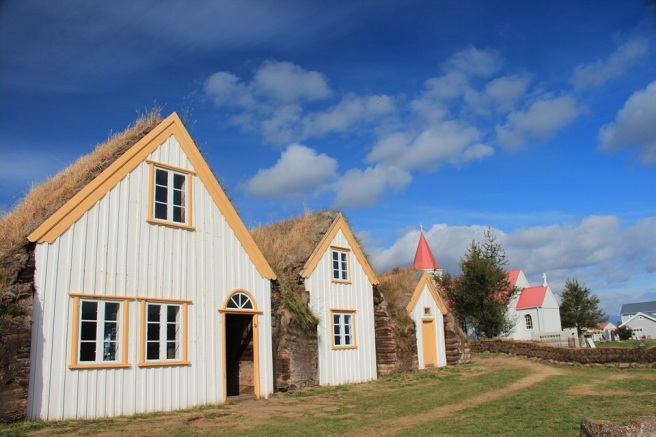
It’s still May, which means I should be studying Swedish. But I just can’t concentrate on Swedish when I’m flying Icelandic Air and getting to see and hear the lovely Icelandic language. Did you know that the Icelandic word for Saturday is Laugardagur, which comes from the old word for bath + day (because apparently Saturday used to be their bath day)? I didn’t, but Icelandic Air had a helpful sign in their bathroom explaining it.
Icelandic Air is quite a nice airline, and included a TV with free programing to watch (they also sell simply divine Icelandic chocolate. It made the hours of flying a little easier). I do admit that I watched several episodes of Friends and How I Met Your Mother (doing exactly 0 language practice), but I ALSO spent time watching Icelandic programs. One was a children’s program meant to teach pronunciation to foreign speakers, which was quite helpful (although a tad dull). The other was a travel program whose name I sadly forgot.
Feeling inspired by all the Icelandic, I pulled out my Icelandic grammar book, Hippocrene’s Beginner’s Icelandic. My previous Icelandic efforts were quite feeble, so I hadn’t really gotten past the introductions. I had been hoping the grammar would be very similar to Swedish (read: ridiculously easy), but alas, it is not.
First off, Icelandic conjugates the verbs. While in Swedish you use talar whether you are saying I speak, you speak, or he speaks, in Icelandic, the verb changes depending on who is doing the speaking (which is what we do in English as well). I speak is ég tala, you speak is þu talar and he speaks is hann talar. In the plural it can take quite a left turn – we speak is við tölum. Not only that, but there are five categories of regular verbs, plus the irregulars. In contrast, French and Spanish only have three categories of verbs (although they also have a host of irregulars).
Icelandic also has cases, which I have battled with before in Russian and German. Cases, by the way, mean that nouns (and also adjectives, personal pronouns, etc.) change depending on what the word is doing in a sentence. English has very limited cases. We say “I love the dog” and “He loves me.” I and me are referring to the same individual, but the word has changed because what it is doing in the sentence – “I” is the subject, while “me” is the object. The way this plays out in Icelandic is that the word “dog” is hundar/hund/hundi/hunds depending on what it is doing in the sentence. Thankfully, there are only four cases in Icelandic (as opposed to languages like Russian and Latin, which have six).
Lastly, Icelandic has three genders (male, female, and neuter), as opposed to Swedish’s two.
Cases, verb conjugation, and three genders means that there’s more to memorize/learn in Icelandic, but challenges are not a bad thing in language learning!
I did discover, much to my delight, that Swedish has helped me out with Icelandic vocabulary (not surprising, given that they are related). Words like maybe (kanske in Swedish/kannski in Icelandic), cheese (ost/ostur), butter (smör/smjör), big (stor/stór), day (dag/dagur), and with (med/með) are easier to pick up in Icelandic since I’ve already spent time learning their equivalent in Swedish – and studying them in Icelandic helps me practice my Swedish! Being able to see connections between languages is one of my absolute favorite things about studying a variety of languages. I love seeing how Icelandic and Swedish are similar and different.
I am now in Cardiff and am being thrilled by all the Welsh signs. I have heard absolutely no one speak Welsh yet, but I am busying myself with some Welsh practice. I am bouncing back and forth between Welsh and Icelandic. The plan is to spend a week in Wales, then spend three days in Iceland on the return trip. I will see how far I can get before then! I also need to gain courage to actually use my limited Icelandic – I was too embarrassed to even say “bless” (goodbye) or “takk” (thanks) to the stewardesses.
